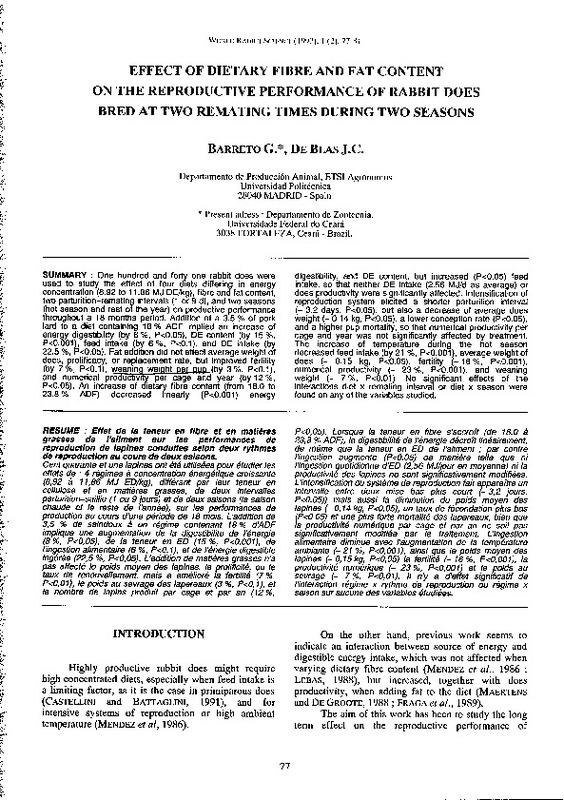JavaScript is disabled for your browser. Some features of this site may not work without it.
Buscar en RiuNet
Listar
Mi cuenta
Estadísticas
Ayuda RiuNet
Admin. UPV
Effect of dietary fibre and fat content on the reproductive performance of rabbit does bred at two remating times during two seasons
Mostrar el registro sencillo del ítem
Ficheros en el ítem
| dc.contributor.author | Barreto, G.
|
|
| dc.contributor.author | De Blas, J.C.
|
|
| dc.date.accessioned | 2011-03-23T12:55:33Z | |
| dc.date.available | 2011-03-23T12:55:33Z | |
| dc.date.issued | 1993 | |
| dc.identifier.issn | 1257-5011 | |
| dc.identifier.uri | http://hdl.handle.net/10251/10562 | |
| dc.description.abstract | [EN] One hundred and forty one rabbit does were used to study the effect of tour diets differing in energy concentration (8.92 to 11.86 MJ DE/kg), fibre and fat content, two parturition-remating intervals (1 or 9 d), and two seasons (hot season and rest of the year) on productiva performance throughout a 18 months period. Addition of a 3.5 % of pork lard to a diet containing 18 % ADF implied an increase of energy digestibility (by 8 %, P<0.05), DE content (by 15 %, P<0.001), feed intake (by 6 %, P<0.1), and DE intake (by 22.5 %, P<0.05). Fat addition did not affect average weight of does, prolificacy, or replacement rate, but improved fertility (by 7%, P<0.1), weaning weight per pyp (by 3%, P<0.1), and numerical proauctivífy per cage and year (by 12 %, P<0.05). An increase of dietary fibre content (from 18.0 to 23.8 % ADF) decreased linearly (P<0.001) energy digestibility, and DE content, but increased (P<0.05) feed intake, so that neither DE intake (2.56 MJ/d as average) or does productivity were significantly affected. lntensification of reproduction system elicited a shorter parturition interval (- 3.2 days, P<0.05), but also a decrease of average does weight (- 0.14 kg, P<0.05), a lower conception rate (P<0.05), and a higher pup mortality, so that numerical productivity per cage and year was not significantly affected by treatment. The increase of temperatura during the hot season decreased feed intake (by 21 %, P<0.001), average weight of does (- 0.15 kg, P<0.05), fertility (- 16 %, P<0.001), numerical productivity (- 23 %, P<0.001), and weaning weight (- 7 %, P<0.01). No significant effects of the interactions diet x remating interval or diet x season were found on any of the variables studied. | es_ES |
| dc.description.abstract | [FR] Cent quarante et une tapines ont été utilisées pour étudier les effets de : 4 régimes a concentration énergétique croissante (8,92 a 11,86 MJ ED/kg), différant par leur teneur en cellulose et en matieres grasses, de deux intervalles parturition-saillie (1 ou 9 jours) et de deux saisons (la saison chaude et le reste de l'année), sur les performances de production au cours d'une période de 18 mois. L'addition de 3,5 % de saindoux a un régime contenant 18 % d'ADF implique une augmentation de la digestibilité de l'énergie (8 %, P<0,05), de la teneur en ED (15 %, P<0,001), de l'ingestion alimentaire (6 %, P<O, 1), et de l'énergie digestible ingérée (22,5 %, P<0,05). L'addition de matieres grasses n'a pas affecté le poids moyen des lapines, la prolificité, ou le taux de renouvellement, mais a amélioré la fertilité (7 %, P<0,01), le poids au sevrage des lapereaux (3 %, P<O, 1), et le nombre de lapins produit par cage et par an (12 %, P<0,05). Lorsque la teneur en fibre s'accroit (de 18,0 a 23,8 % ADF), la digestibilité de l'énergie décroit linéairement, de meme que la teneur en ED de l'aliment ; par contre l'ingestion augmente (P<0.05) de maniere te/le que ni l'ingestion quotidienne d'ED (2,56 MJ/jour en moyenne) ni la productivité des lapines ne sont significativement modifiées. L 'intensification du systeme de reproduction fait apparaitre un intervalle entre deux mise bas plus court (- 3,2 jours, P<0,05)) mais aussi la diminution du poids moyen des tapines (-O, 14 kg, P<0,05), un taux de fécondation plus bas (P<0,05) et une plus forte mortalité des lapereaux, bien que la productivité numérique par cage et par an ne soit pas significativement modifiée par le traitement. L 'ingestion alimentaire diminue avec l'augmentation de la température ambiante (- 21 %, P<0,001), ainsi que le poids moyen des lapines (-O, 15 kg, P<0,05) la fertilité (- 16 %, P<0,001), la productivité numérique (- 23 %, P<0,001) et le poids au sevrage (- 7 %, P<0,01). 11 n'y a d'effet significatif de l'interaction régime x rythme de reproduction ou régime x saison sur aucune des variables étudiées. | |
| dc.description.sponsorship | This study has been supported with funds provided by CICYT (Project nº 90/83) and CDTI Eureka Program (EU-619) | |
| dc.language | Inglés | es_ES |
| dc.publisher | World Rabbit Science. ICTA. UPV | es_ES |
| dc.relation.ispartof | World Rabbit Science | |
| dc.rights | Reserva de todos los derechos | es_ES |
| dc.title | Effect of dietary fibre and fat content on the reproductive performance of rabbit does bred at two remating times during two seasons | es_ES |
| dc.type | Artículo | es_ES |
| dc.date.updated | 2011-03-23T12:39:28Z | |
| dc.identifier.doi | 10.4995/wrs.1993.198 | |
| dc.relation.projectID | info:eu-repo/grantAgreement/CICYT//90%2F83 | |
| dc.relation.projectID | info:eu-repo/grantAgreement/CDTI//EU-619/ | |
| dc.rights.accessRights | Abierto | es_ES |
| dc.description.bibliographicCitation | Barreto, G.; De Blas, J. (1993). Effect of dietary fibre and fat content on the reproductive performance of rabbit does bred at two remating times during two seasons. World Rabbit Science. 01(2):77-81. https://doi.org/10.4995/wrs.1993.198 | es_ES |
| dc.description.accrualMethod | SWORD | es_ES |
| dc.relation.publisherversion | https://doi.org/10.4995/wrs.1993.198 | |
| dc.description.upvformatpinicio | 77 | |
| dc.description.upvformatpfin | 81 | |
| dc.description.volume | 01 | |
| dc.description.issue | 2 | |
| dc.identifier.eissn | 1989-8886 | es_ES |
| dc.contributor.funder | Comisión Interministerial de Ciencia y Tecnología | |
| dc.contributor.funder | Centro para el Desarrollo Tecnológico Industrial |








